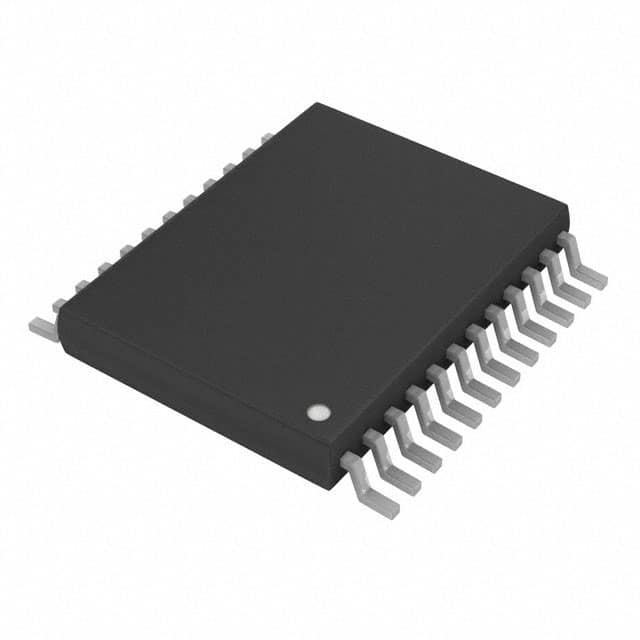SN74LVTH646DGVRE4
Product Overview
- Category: Integrated Circuit (IC)
- Use: Level Shifter and Bus Transceiver
- Characteristics: High-speed, low-voltage, 3.3V to 5V translation, bidirectional, 3-state outputs
- Package: TSSOP-24
- Essence: This IC is designed to provide level shifting and bus transceiver functionality between devices operating at different voltage levels.
- Packaging/Quantity: Available in reels of 2500 units.
Specifications
- Supply Voltage Range: 2.7V to 3.6V
- Logic Voltage Levels: 1.65V to 3.6V
- Input/Output Compatibility: 5V TTL/CMOS
- Maximum Data Rate: 400 Mbps
- Number of Channels: 8
- Output Drive Strength: ±12 mA
- Operating Temperature Range: -40°C to +85°C
Detailed Pin Configuration
The SN74LVTH646DGVRE4 has a total of 24 pins, which are assigned as follows:
- OE (Output Enable) 1
- A1 (Data Direction Control) 1
- A2 (Data Direction Control) 2
- GND (Ground)
- B1 (Data Direction Control) 3
- B2 (Data Direction Control) 4
- VCC (Supply Voltage)
- B3 (Data Direction Control) 5
- B4 (Data Direction Control) 6
- B5 (Data Direction Control) 7
- B6 (Data Direction Control) 8
- B7 (Data Direction Control) 9
- B8 (Data Direction Control) 10
- DIR (Direction Control)
- OE (Output Enable) 2
- I/O1 (Bidirectional Data I/O) 1
- I/O2 (Bidirectional Data I/O) 2
- I/O3 (Bidirectional Data I/O) 3
- I/O4 (Bidirectional Data I/O) 4
- I/O5 (Bidirectional Data I/O) 5
- I/O6 (Bidirectional Data I/O) 6
- I/O7 (Bidirectional Data I/O) 7
- I/O8 (Bidirectional Data I/O) 8
- GND (Ground)
Functional Features
- Bidirectional voltage level shifting between 3.3V and 5V logic levels.
- 3-state outputs allow multiple devices to share a common bus.
- Output enable pins provide control over the direction of data flow.
- High-speed operation with a maximum data rate of 400 Mbps.
- Low-voltage operation with a supply voltage range of 2.7V to 3.6V.
Advantages and Disadvantages
Advantages: - Enables communication between devices operating at different voltage levels. - Provides bidirectional data transfer capability. - Supports high-speed data transmission. - Offers 3-state outputs for bus sharing.
Disadvantages: - Limited to specific voltage level translation (3.3V to 5V). - Requires careful consideration of input/output compatibility.
Working Principles
The SN74LVTH646DGVRE4 utilizes a combination of level shifting circuitry and bidirectional transceivers to enable communication between devices operating at different voltage levels. The direction of data flow is controlled by the DIR pin, while the OE pins enable or disable the outputs. The IC ensures reliable data transmission by providing 3-state outputs, allowing multiple devices to share a common bus without interference.
Detailed Application Field Plans
The SN74LVTH646DGVRE4 is commonly used in various applications, including:
- Microcontroller interfacing with peripherals operating at different voltage levels.
- Communication between devices using different logic families (e.g., TTL and CMOS).
- Level shifting in mixed-voltage systems, such as automotive electronics and industrial control systems.
- Bus transceiver functionality in data communication networks.
Detailed and Complete Alternative Models
- SN74LVC4245A: Octal Bus Transceiver with 3-State Outputs
- SN74AVC4T245: 4-Bit Dual-Supply Bus Transceiver with Configurable Voltage Translation
- SN74LVC8T245: 8-Bit Dual-Supply Bus Transceiver with Configurable Voltage Translation
- SN74LVC2T45: Dual-Bit Dual-Supply Bus Transceiver with Configurable Voltage Translation
- SN74LVC16T245: 16-Bit Dual-Supply Bus Transceiver with Configurable Voltage Translation
These alternative models offer similar functionality to the SN74LVTH646DGV
Senaraikan 10 soalan dan jawapan biasa yang berkaitan dengan aplikasi SN74LVTH646DGVRE4 dalam penyelesaian teknikal
Sure! Here are 10 common questions and answers related to the application of SN74LVTH646DGVRE4 in technical solutions:
Q: What is SN74LVTH646DGVRE4? A: SN74LVTH646DGVRE4 is a high-performance octal bus transceiver with 3-state outputs, designed for asynchronous communication between buses operating at different voltage levels.
Q: What is the operating voltage range of SN74LVTH646DGVRE4? A: SN74LVTH646DGVRE4 operates within a voltage range of 2.7V to 3.6V.
Q: How many channels does SN74LVTH646DGVRE4 have? A: SN74LVTH646DGVRE4 has 8 bidirectional channels, allowing data transmission in both directions.
Q: What is the maximum data transfer rate supported by SN74LVTH646DGVRE4? A: SN74LVTH646DGVRE4 supports a maximum data transfer rate of 400 Mbps.
Q: Can SN74LVTH646DGVRE4 be used for level translation between different voltage domains? A: Yes, SN74LVTH646DGVRE4 can be used for level translation between 3.3V and 5V voltage domains.
Q: Does SN74LVTH646DGVRE4 have built-in ESD protection? A: Yes, SN74LVTH646DGVRE4 has built-in ESD protection, making it more robust against electrostatic discharge events.
Q: Can SN74LVTH646DGVRE4 be used in hot-swapping applications? A: Yes, SN74LVTH646DGVRE4 supports hot-swapping, allowing for the insertion and removal of devices without disrupting the operation of the system.
Q: What is the power supply current consumption of SN74LVTH646DGVRE4? A: The power supply current consumption of SN74LVTH646DGVRE4 is typically around 10 mA.
Q: Does SN74LVTH646DGVRE4 have any special features for bus hold or bus isolation? A: Yes, SN74LVTH646DGVRE4 has a bus-hold feature that retains the last valid logic level on the inputs when they are in a high-impedance state.
Q: Can SN74LVTH646DGVRE4 be used in automotive applications? A: Yes, SN74LVTH646DGVRE4 is qualified for automotive applications and meets the necessary standards for reliability and performance in automotive environments.
Please note that these answers are general and may vary depending on the specific requirements and use cases. It's always recommended to refer to the datasheet and consult with the manufacturer for detailed information.


